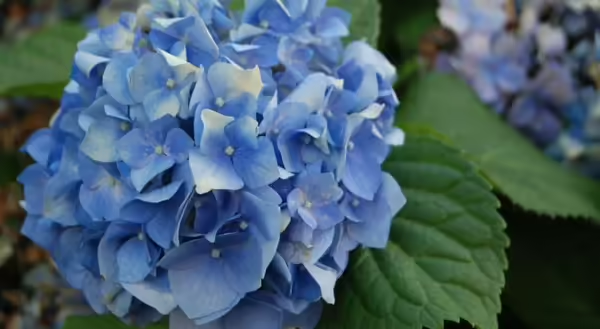
Red, white, and blue will make a statement on flagpoles, porches, street corners—even truck beds—this holiday weekend. Join the celebration, plant a festive garden of patriotic color around your flagpole or a red, white and blue front door container to celebrate Independence Day. The addition of blue flowers to your red and white garden is tricky to accomplish, only around 10% of the flowering plants on earth produce blue flowers, but the addition is certain to make a patriotic statement.
Blue creates a sense of peace and calmness in a space. While blues are not commonly occurring colors in nature, more blue flowers are being developed and bred every year for gardeners to add to their gardens. Blue flowers can be incorporated into any landscape to brighten up a space or even balance out areas with a lot of popular warm-toned flowers.
Although blue flowers are less common in garden centers, each plant possessing this mellow color is unique, possessing a different shape, size or sunlight need, ensuring a blue hue for any spot. With a variety of plant selections, all shades of blue can bloom in your garden from early spring through fall.
Spring-flowering bulbs are the first to provide color to the landscape after a dull, colorless winter.
Virginia bluebells (Mertensia virginica) is a gorgeous spring ephemeral with drooping blue, bell-shaped flowers atop 2-foot tall clumping foliage. They can form large groupings over time—a stunning sight to see!
Grape hyacinth (Muscari armeniacum) produces clusters of small, bell-shaped blooms, with grass-like foliage. Only reaching 5-8 inches tall, they are great naturalizers and pollinator favorites.
Annual plants provide continuous colorful blooms throughout the summer and are great additions to your landscape or your patriotic patio pot.
‘Black and Blue’ salvia (Salvia guaranitica) have showstopping cobalt blue blooms with black whorls that appear on spikes 2-4 feet tall. Pleasant fragranced foliage and heat and drought tolerance (once established) make this a favorite for containers or annual plantings.
Blue Daze (Evolvulus glomeratus) blooms with bright blue flowers amongst a mat of small, fuzzy leaves that trail when planted in baskets or containers. The flowers are sun lovers that close up on cloudy days and at night.
Blue-blooming shrubs can add form and structure to your landscape all year in addition to the rare blue color.
Bigleaf hydrangea (Hydrangea macrophylla) is a shade-loving shrub with large clusters of smaller flowers. Blue flowers are produced in acidic soil (pH of 5.0 to 5.5). Aluminum sulfate can be added to the soil to lower the pH.
Bluebeard (Caryopteris clandonensis) bursts with dark blue blooms covering the branches in later summer. The 3-4 ft shrub is a great nectar source for pollinators.
Perennials with gorgeous blue blooms can be planted in any sun or shade garden and will come back year after year.
Blue false indigo (Baptisia australis) has pea-like, indigo blue flowers that appear above blue-green foliage in late spring to early summer. Low maintenance and easily adapted to a variety of conditions make it garden worthy.
Bluestar (Amsonia tabernaemontana) is a mid-spring bloomer with powder blue, star-shaped blooms amongst upright, clumping foliage.
PHOTO CREDIT: Blue Hydrangea by HeatherMarieColeman is licensed under CC BY 2.0.
ABOUT THE AUTHOR: Brittnay Haag is a Horticulture Educator with University of Illinois Extension, serving Livingston, McLean, and Woodford Counties. Her work focuses on youth horticulture education, specifically through school gardens and Jr. Master Gardener programs. Brittnay provides leadership for three county Master Gardener programs and is responsible for developing community programs and providing expertise in horticulture and environmental sciences.